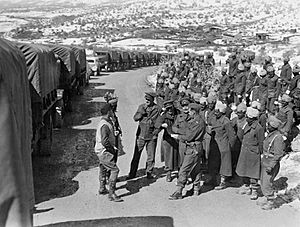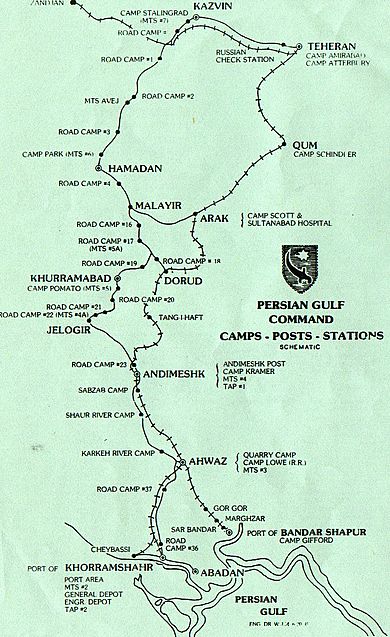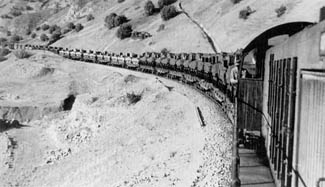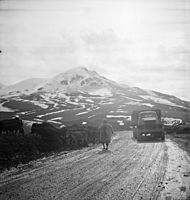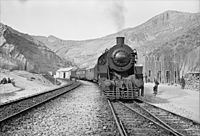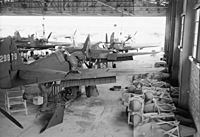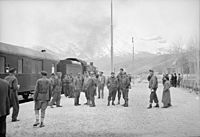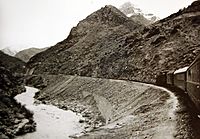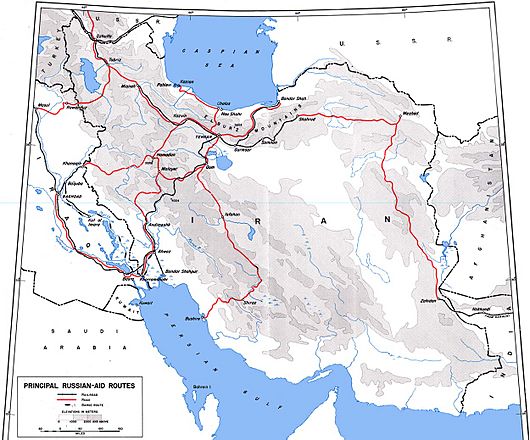Persian Corridor facts for kids
The Persian Corridor was a super important supply route during World War II. It went through Iran (which used to be called Persia) and into Soviet Azerbaijan. This route was used by Britain and the United States to send vital supplies to the Soviet Union.
Imagine a huge amount of help! Out of all the supplies the US sent to the Soviet Union through a program called Lend-Lease, almost half (about 7.9 million long tons) traveled through Iran.
These supplies started in the US and the UK. Ships sailed all the way around the Cape of Good Hope (the southern tip of Africa) to reach the Persian Gulf. From there, the goods traveled across Iran to the Soviet Union. There were other ways to send supplies, like the Northern route through the icy Arctic, or the Pacific Route which went to Vladivostok and then used the Trans-Siberian Railway.
But the Persian Corridor became the most reliable route. It could be used in all kinds of weather, which was very important for getting supplies where they needed to go.
Contents
Why it was called the Persian Corridor
Even though the country was called Iran, official papers from that time often used "Persia" and "Iran" to mean the same thing. Winston Churchill, who was the Prime Minister of the United Kingdom, preferred using "Persia." He wanted to avoid confusing it with neighboring Iraq.
Iran's Role in the War
When Germany invaded the Soviet Union in June 1941, Britain and the Soviet Union became allies. They saw the new Trans-Iranian Railway as a great way to move supplies from the Persian Gulf to the Soviet Union.
Iran was a neutral nation at the time. However, Britain and the Soviet Union pressured Iran to let them use its land for military and supply purposes. This caused some tension, and people in Tehran even held rallies supporting Germany.
In August 1941, because Iran's ruler, Reza Shah, wouldn't send away all German citizens or clearly join the Allies, Britain and the Soviet Union invaded Iran. They took control of Iran's communication systems and the important railway. Reza Shah was sent away to South Africa.
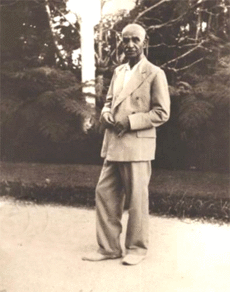
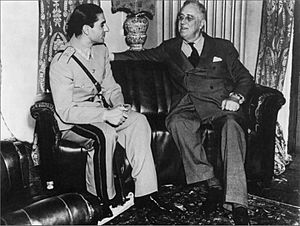
In 1942, the United States joined Britain and the Soviet Union as an ally. The US sent its own military forces to Iran to help manage and run parts of the railway. The British and Soviet forces allowed Reza Shah's government system to change. They put Reza Shah's son, Mohammad Reza Pahlavi, on the throne.
The new Shah quickly signed an agreement. He promised to fully help with supplies for the British and Soviets. In return, his country's independence was recognized. The Allies also promised to leave Iran within six months after the war ended. This promise was very important for Iran's independence later on. In September 1943, the Shah even declared war on Germany. He signed the Declaration by United Nations, which meant Iran could have a seat in the new United Nations. A couple of months later, he hosted the Tehran Conference where Churchill, Roosevelt, and Stalin met.
Having so many foreign troops in Iran brought big changes to the country. It also made people feel more nationalistic. In 1946, a song called Ey Iran was written. It was inspired by an event during the war where an American soldier reportedly argued with an Iranian greengrocer.
Why the Soviets Needed Supplies
After the Dunkirk evacuation in 1940, Germany had no major military opposition in mainland Europe. But then, in June 1941, Hitler launched Operation Barbarossa, invading the Soviet Union. To help the Soviets, British and later American leaders wanted to open a "Second Front" in Europe. This meant attacking Germany from another side.
However, opening a new front would take time. So, the Western Allies decided to send a lot of material support to the Soviet Union. This was to make sure the Soviet army could keep fighting against most of the German military. The Allies made agreements about what supplies would be sent and when. German attacks on the Arctic route made it hard to meet the first supply goals. This put more pressure on the Allies to develop the Persian Corridor.
How Supplies Were Delivered
The Allies sent all kinds of supplies to the Soviet Union. This included Studebaker US6 trucks and American canned food. Most of the supplies that went through the Persian Corridor arrived by ship at ports in the Persian Gulf. From there, they were carried north by railroad or in long truck convoys. Some goods were then put on other ships to cross the Caspian Sea, while others continued their journey by truck.
The United States Army forces working in the corridor were first called the Iran-Iraq Service Command. Later, it was renamed the Persian Gulf Service Command (PGSC). This group was in charge of delivering Lend-Lease supplies even before the US officially joined World War II.
Supply Facts and Figures
Out of the 17.5 million long tons of US Lend-Lease aid sent to Russia, 7.9 million long tons (45%) went through Iran. Besides the Persian Corridor, Americans also used Arctic Convoys to ports like Murmansk and Archangelsk. Soviet ships carried supplies from the west coast of the US and Canada to Vladivostok in the Far East. This was because the Soviets were not at war with Japan until August 1945.
The Persian Corridor alone carried 4,159,117 long tons of cargo. But that wasn't the only help. About 7.9 million long tons of cargo from Allied ships were unloaded in the Corridor. Most of this was for the Soviet Union. Some was for British forces or for the Iranian economy, which was supporting thousands of foreign troops and Polish refugees. Supplies were also needed to build new transport and supply facilities in Iran and the Soviet Union. This number doesn't even include warplanes sent through Persia.
Supply Routes and Locations
Supplies came from far away places like Canada and the United States. They were unloaded at ports in the Persian Gulf, in Iran and Iraq. After 1943, when the Allies cleared the Mediterranean Sea of Axis powers, cargo ships could pass through the Mediterranean, the Suez Canal, and the Red Sea to Iran.
The main ports in the Corridor for supplies coming into Iran were:
- In Iran:
* Bushehr * Bandar Shahpur (now called Bandar Imam Khomeini)
- In Iraq:
* Basra * Umm Qasr
The main land routes went from these ports to Tehran. Then, they continued:
Or, other routes included:
The main port for supplies leaving Iran (by crossing the Caspian Sea) was Nowshahr. Ships carried supplies from Nowshahr to Baku or Makhachkala.
Other Important Places
Smaller but important ports and transit points along the routes included:
In Azerbaijan
In Armenia
In Georgia
In North Ossetia-Alania
- Beslan
In Iran
Ports
- Bandar Anzali
- Bandar Abbas
- Chabahar
- Noshahr
- Bandar-e Shah (now Bandar Torkoman)
- Amir Abad port
- Khoramshahr
- Bushehr
- Assalouyeh
- Mahshahr
- Bandar Shahpur
- Fereydunkenar
Cities
- Andimeshk
- Tehran
- Tabriz
- Hamadan
- Isfahan
- Karaj
- Khorramabad
- Kashan
- Malayer
- Mashad
- Mianeh
- Sari, Iran
- Semnan
- Shahroud
- Shiraz
- Tabriz
- Qom
- Zanjan
- Zahedan
In Turkmenistan
Ports
- Krasnovodsk
Cities
- Ashgabat
- Kizyl Arvat
- Kizyl Atrek
People Involved
The cargo was mainly handled by special British and American transportation groups. These included the Royal Army Service Corps and the United States Army Quartermaster Corps. Many Allied civilian workers, like stevedores (people who load and unload ships) and railway engineers, also worked on the corridor. Many skilled engineers and other professionals who joined the armed services were made warrant officers to help manage the complex supply operations.
Besides helping with supplies, the Allies also offered other services to the Iranians. Americans were seen as more neutral because they didn't have a history of controlling the country like the British and Soviets. Americans shared their special skills with the young Shah's government. For example, Colonel Norman Schwarzkopf, Sr., who was a police superintendent before the war, was put in charge of training the Imperial Iranian Gendarmerie in August 1942. (His son, Norman Schwarzkopf, Jr., would later lead forces during the Persian Gulf War fifty years later.)
Equipment Used
To help run trains on the challenging Trans-Iranian Railway, the US sent many ALCO diesel locomotives. These were better suited for the route than steam locomotives. About 3,000 other types of train cars were also supplied.
-
An assembly plant for American Curtiss P-40 fighters destined for Russia, somewhere in Iran. c.1943
Volga River and Stalingrad
Beyond the Persian Corridor and across the Caspian Sea is the Volga River. This river flows into the Caspian from the north and was a key route into the heart of the Soviet Union. Stalingrad, located at the easternmost bend of the Volga, was a target for the Germans in their 1942 campaign. They wanted to capture it partly because of its factories, partly to block Soviet forces, and partly because of its name. But it was also important for blocking river traffic carrying supplies north from the Persian Corridor. The Battle of Stalingrad (August 23, 1942 – February 2, 1943) was a huge battle that eventually reopened the river for Soviet use.
See also
- History of Iran
- Mediterranean and Middle East Theatre
- Military history of the Soviet Union
- Polish contribution to World War II
- Anglo-Soviet invasion of Iran
- Anglo-Russian Treaty of 1907
- Royal Road
- Operation Cedar
- Burma Road
